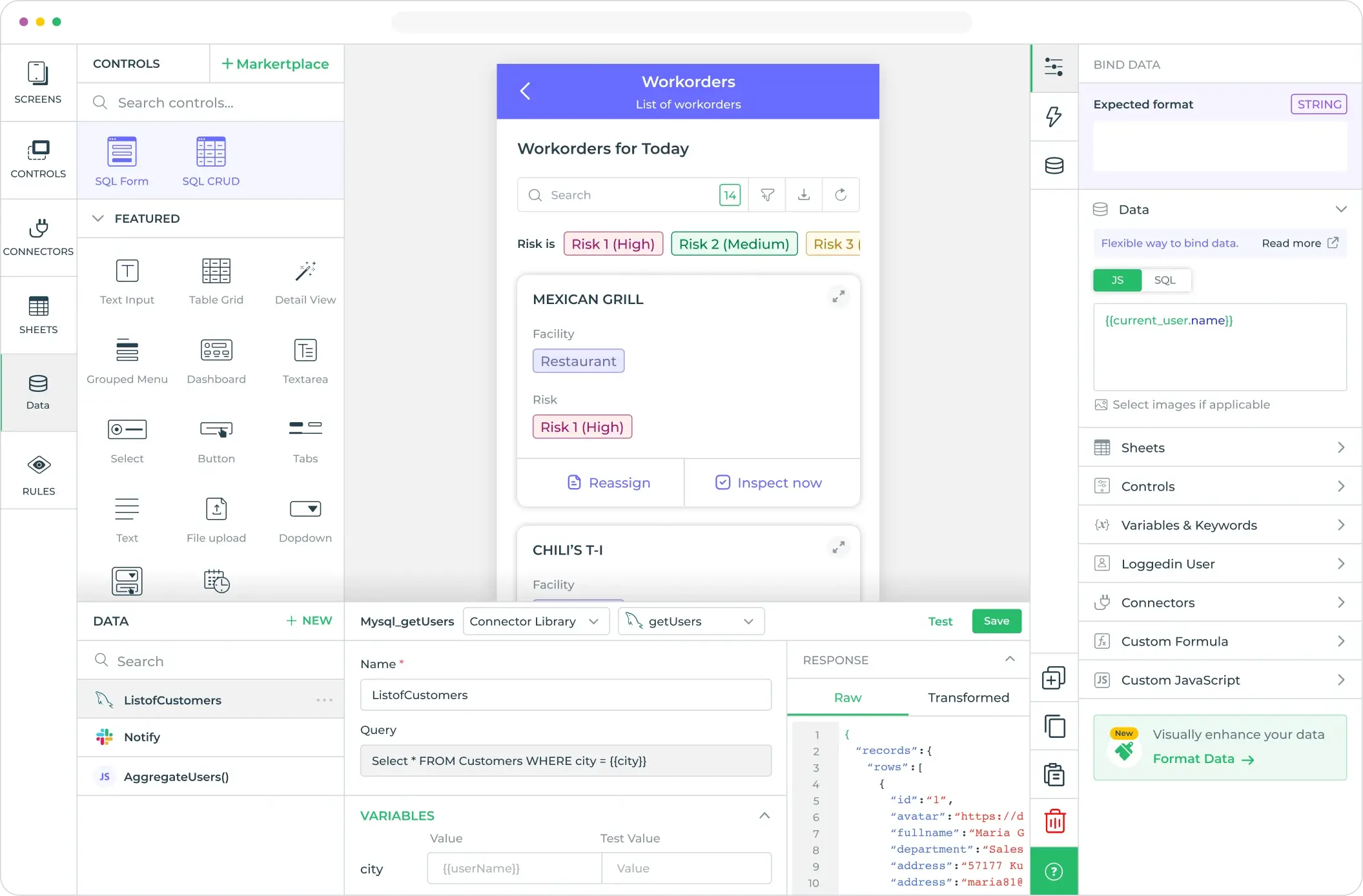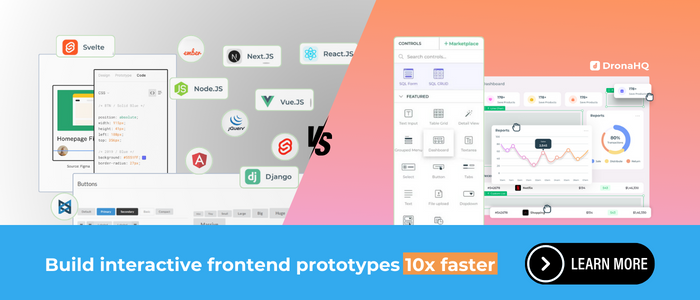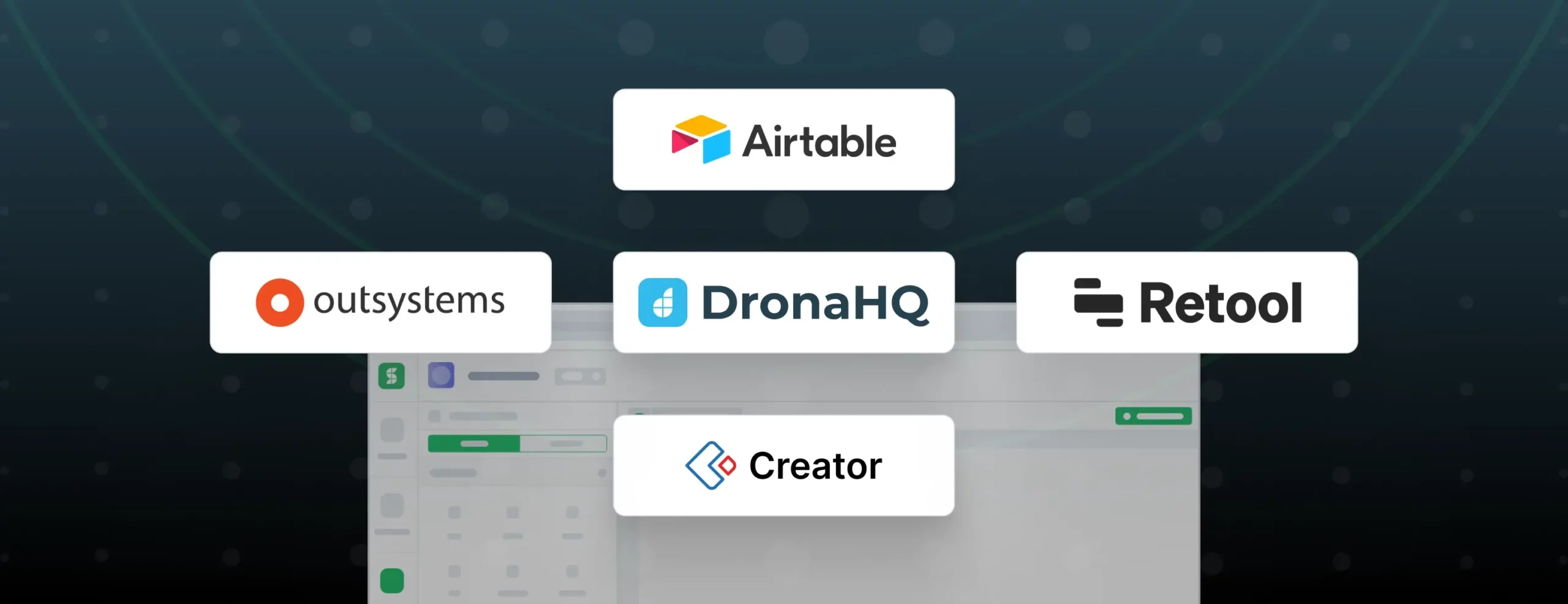

9-step guide to choose the right low-code platform
What do you need to build? Have you considered your use case? What features are you looking for? What about customization options? What’s your budget? Do you not have a precise answer to these questions? You need to stop your search!
Set to hit $187 billion by 2030, low-code technology continues to be a game-changer for custom application development.
“Organizations are increasingly turning to low-code development technologies to fulfil growing demands for speed application delivery and highly customized automation workflows,” said Varsha Mehta, Senior Market Research Specialist at Gartner. “Equipping both professional IT developers and non-IT personas — business technologists — with diverse low-code tools enables organizations to reach the level of digital competency and speed of delivery required for the modern agile environment.”
But don’t adopt a low-code platform just because “low-code development” is the trending buzzword. How to choose the right low-code development platform is a strategic process. You have to go step by step so that your investment is an investment, not an expense.
This 10-step guide on choosing the right low-code development platform will help you better decide.
Note: The steps below may make it seem like there are a lot of moving parts you need to understand and manage, but that is exactly what a quality low-code platform brings to the table. So, let’s begin.
What is Low-Code development?
Simply put, low-code development allows developers (experienced as well as beginners)to develop software applications using low-code development platforms. These platforms often come with visual interfaces, pre-built components, and drag-and-drop functionality that simplifies the software development processes.
Note: Low-code platforms are designed for individuals who wish to save frontend development time by using pre-built UI components and out-of-the-box capabilities but still be able to use JS, database querying, and CSS styling for customizations. Not to be confused with no-code platforms that require zero lines of code but offer limited to no flexibility.
Read more about: What is low-code and how it is different from no-code.
You must pick the right tool because the type of tool you choose:
- Impacts development speed and agility.
- Influences scalability and customization capabilities.
- Shapes user experience and interface design.
- Impacts security and compliance features.
- Drives collaboration and developer ecosystem.
What are the benefits of choosing the right low-code development tool?
The benefits of low-code development are multiple. But those benefits come with a condition—the platform you have is the right low-code platform for your business needs.
Once you pick the right low-code tool for your needs, you can get the following benefits:
Faster application development
Low code development platforms offer pre-built templates, modules, and visual development tools that significantly reduce the need for extensive manual coding. As a result, development tasks that once took weeks or even months can now be accomplished in a fraction of the time. This speed translates into faster time-to-market for your applications, a crucial factor in today’s competitive digital landscape, where being the first to offer a solution can be a game-changer.
Increased productivity and efficiency
Low code platforms streamline the development workflow, optimizing the utilization of your development teams’ skills and time. By automating routine and repetitive tasks, developers can focus their expertise on solving complex challenges and crafting unique features. This enhanced productivity accelerates project completion and ensures that your development resources are used more efficiently, ultimately delivering more value for your business.
Cost savings
Choosing the right low-code platform holds significant financial benefits. Firstly, it trims labor costs by reducing development time and minimizing extensive coding. Secondly, it enables non-technical staff, often called citizen developers, to participate in app development actively, reducing the need for expensive specialized coders. This translates to substantial long-term cost reductions that can be reinvested in various business areas or used to fuel further innovation.
Empower citizen developers and junior developers
Low-code platforms are designed to democratize application development. While they help cut down considerable engineering hours, they empower business users and citizen developers to create and modify applications with minimal IT involvement. This shift in responsibility alleviates the IT team’s workload and enables them to focus on more strategic and complex tasks. As a result, your IT department becomes more agile and responsive, capable of addressing critical business needs while ensuring the smooth operation of your digital ecosystem.
Agile development and rapid frontend prototyping
Finally, the right low-code platform fosters agility in your development process. It enables you to adapt quickly to changing project requirements, allowing your business to respond swiftly to market shifts or evolving business needs. Additionally, low-code platforms make rapid prototyping feasible, facilitating the creation of interactive prototypes for testing and validation. This iterative approach enhances the quality and relevance of your applications, ensuring they align closely with your business goals and end-user needs.
What are some factors to consider when choosing a low-code development platform?
When it comes to selecting the right low-code development platform for your business, several crucial factors must be considered. Let’s take a hypothetical example of “Z Electronics” and see how it considered these factors when choosing a low-code development platform.
Use case
Define the specific use case or project for which you require the low-code platform. Different platforms excel in various domains. (According to Gartner, there are 7 broad categories of low-code technologies.)
Understanding your unique needs will help you narrow down your options.
For example, if a company Acme Electronics wants to enhance its customer experience by creating a mobile app that allows customers to browse and purchase electronic gadgets. Their use case is clear: they need a low-code platform that is:
- Specializing in mobile app development to create an
- Easy-to-use branded shopping app experience and that
- Is performant (Does not crash as data and users grow)
Usability
A user-friendly interface is essential. Ensure that your platform is intuitive and requires minimal technical expertise, enabling your team to work efficiently and effectively.
If our example company Acme Electronics doesn’t have an extensive IT team, they need a low-code platform that is
- User-friendly, intuitive, with a shortest learning curve
- Offer a visual interface and pre-built templates
- Allows junior developers to quickly design and deploy the app without requiring advanced coding skills.
Customization options
Evaluate the platform’s customization capabilities. It should allow you to tailor your applications to meet your specific business requirements, ensuring a seamless fit with your business’s processes if Acme Electronics wants to set itself apart from competitors by offering unique features in its app, such as personalized product recommendations. They need a low-code platform offering extensive customization options, enabling them to tailor the app to their business requirements and meet their app styling and branding requirements.
Integration capabilities
Consider the platform’s ability to integrate with your existing software and systems. A robust integration feature is vital for maintaining a cohesive and interconnected digital environment. To ensure smooth order processing, Acme Electronics needs the app to integrate with its existing inventory management system and payment gateway. They must choose a low-code platform with strong integration capabilities to ensure that data flows seamlessly between the app and their backend systems. Ready connectors to the database and services of choice will be a major advantage.
Scalability
Think about the long-term growth of your applications. The chosen platform should offer scalability, enabling you to expand and adapt your solutions as your organization evolves. Acme Electronics envisions growth in customer traffic and product offerings. Therefore, they require a low-code platform that can handle increased user loads and accommodate additional features as their business expands. Scalability ensures that the app remains responsive even during periods of high demand.
Security features
Security is paramount. Ensure that the low-code platform provides robust security features to safeguard your applications and sensitive data from potential threats and breaches. As a retailer dealing with customer data and payment information, Acme Electronics cannot compromise on security. They need a low-code platform with robust security features, such as granular permissions, audit logging, and data encryption, to protect customer information and prevent unauthorized access.
Support and community
Investigate the level of support and the presence of an active user community around the platform. This ensures you can access resources and assistance when facing challenges or seeking guidance. While Acme Electronics has a small team, they want to ensure they can access assistance when needed. They value a low-code platform that provides comprehensive support resources, including documentation and responsive customer support. Being part of an active user community helps them exchange ideas and find solutions to any development challenges.
Pricing models
Carefully examine the platform’s pricing models. Consider not only the initial costs but also any additional charges for scalability, support, or additional features.
Different platforms may have various pricing structures, so ensure it aligns with your budget and doesn’t lead to unexpected costs down the road. Acme Electronics operates on a tight budget. They need a low-code platform with a pricing model aligned with their financial constraints. Understanding the platform’s pricing structure, whether based on usage or cost-effective subscription plans, is crucial for managing its expenses effectively as it grows its app.
Additionally, also factor in the:
Platform Reviews
Start your search by researching different low-code platforms. Read reviews from users who have similar use cases to yours.
Trial Periods and Demos
Many low-code platforms offer trial periods or demo versions. Take advantage of these opportunities to test the platform’s features and functionalities. This hands-on experience will provide valuable insights into how well the platform aligns with your development goals.
Evaluate Case Studies
Examine case studies or success stories from organizations that have used the low-code platform. This can offer real-world examples of how the platform has been utilized in different scenarios and industries.
How to Choose The Right Low-Code Development Platform?
Here are ten steps to follow while choosing the right low-code development platform.
Step 1: Identify project requirements and goals
The first step in selecting the right low-code development platform is to identify your project requirements and goals thoroughly. This is crucial because it sets the foundation for choosing a platform that aligns with your specific needs. For instance, if your goal is to rapidly develop a lead data management (Simple CRM) application with basic functionalities, you may not require a complex platform that does not offer a visual interface.
By clearly defining your project requirements and objectives, you can narrow down your platform choices and ensure that the one you select is the best fit for your specific project.
Step 2: Research available low-code development platforms
In the second step of choosing the right low-code development platform, it is essential to explore the options available in the market. This entails actively seeking out low-code platforms that closely align with the specific requirements of your project. By doing so, you can create a concise shortlist of potential platforms that have the potential to meet your project’s needs effectively. This step serves as a critical foundation for the subsequent stages of your decision-making process, ensuring that the platforms you consider are well-suited to your project’s unique demands.
Step 3: Evaluate the ease of use and user interface
Step three in selecting the right low-code development platform is to evaluate the ease of use and the quality of the user interface (UI). This step is crucial because it directly impacts the efficiency of development and the overall user experience. For instance, if you’re building a web application, you will want a platform that offers a user-friendly drag-and-drop interface and intuitive design tools. This would enable citizen developers to create and modify components easily. Ideally, you want a platform that streamlines the UI design process, making it accessible to both technical and non-technical team members.
Step 4: Assess customization options and flexibility
Step four in choosing the right low-code development platform involves assessing its customization options and flexibility. This step is critical to ensure that the platform can adapt to your project’s unique requirements. For example, if you’re developing an e-commerce website, you should look for a low-code platform that allows you to customize the shopping cart functionality, payment gateways, and user interfaces to align with your business’s specific needs. By thoroughly evaluating these customization aspects, you can make sure that the selected low-code platform provides the necessary flexibility to create a highly personalized and functional solution.
Step 5: Consider integration capabilities with existing systems
As the fifth step in choosing the right low-code development platform, consider the platform’s integration capabilities with your existing systems. This evaluation ensures that the chosen platform can seamlessly work with your IT infrastructure. For instance, if your organization relies on various software applications like customer databases or accounting systems, you should look for a low-code platform that easily integrates with these systems. Consider whether the platform offers connectors or APIs to facilitate smooth data exchange. By prioritizing integration capabilities, you can avoid compatibility issues and streamline data flow.
Step 6: Analyze scalability and performance
Selecting the right low-code development platform involves analyzing its scalability and performance capabilities. This assessment is crucial to ensure that the platform can handle the growth and demands of your project over time. For instance, if you’re developing a mobile app, consider whether the platform can support increasing user loads without sacrificing performance. Evaluate its ability to scale to accommodate growing data. By thoroughly analyzing scalability and performance, you can choose a low-code platform that can grow with your project and deliver a consistently high-quality user experience.
Step 7: Review security features and compliance
Review its security features and compliance capabilities in the seventh step of selecting the appropriate low-code development platform. This assessment is paramount to ensure your application meets industry-specific regulations and safeguards sensitive data. For example, if you’re developing a healthcare application, you should confirm that the chosen platform can be deployed on your servers or one that complies with HIPAA regulations for protecting patient information.
Evaluate the platform’s authentication, encryption, and access control features to guarantee data security. Additionally, look for audit trails and logging capabilities that aid in tracking and monitoring security incidents. By thoroughly reviewing these security aspects, you can select a low-code platform that helps you build robust and secure applications and also ensures compliance with relevant industry standards and regulations, reducing potential legal and reputational risks.
Step 8: Seek feedback from current users and the community
In the eighth step of choosing the right low-code development platform, seek feedback from current users and the platform’s community. This step provides valuable insights into the platform’s real-world performance and user satisfaction. For instance, you can browse review sites like G2 and Capterra, the platform’s YouTube playlists (for a deeper understanding of how it works without doing hard work on your own), and community discussions to understand the experiences of others who have used the platform for similar projects.
Look for instances where users have encountered challenges or limitations and how they were addressed. By tapping into this collective knowledge and feedback loop, you can make a more informed decision, gaining a clearer picture of the platform’s strengths, weaknesses, and suitability for your project.
Step 9: Compare pricing and licensing models
In the ninth step of choosing the right low-code development platform, compare the pricing and licensing models offered by different options. This evaluation ensures the platform you choose falls within your budget. For example, some low-code platforms offer subscription-based pricing, while others charge based on the number of users, the complexity of the applications, or the volume of data processed. Additionally, factor in any hidden costs, such as fees for additional features or support. By carefully comparing these pricing and licensing structures, you can make a decision that fits your initial budget and also accommodates your project’s growth without unexpected financial burdens. Opting for a platform that can accommodate multiple licensing options can be a bonus. So you can use the same technology for apps that are operation-heavy but will be used by 5 users, but also the apps that have simple data entry transactions that may be used by unlimited end users.
It helps to create a tabular comparison between the various platforms you are evaluating. You can weigh the parameters that are most important to you and then compare how each platform ranks.
Free platform evaluation scorecard: Download here
Conclusion
Selecting the right low-code development tool is a strategic decision that significantly impacts the success of your software projects. The benefits of reduced development time, cost savings, and increased efficiency are compelling.







